#Middle Ordovician
Text


Fossil Starfish Plaque
Petraster sp.
Middle Ordovician (approx. 467 million years ago)
Erfoud, Morocco
#Fossil Starfish Plaque#Middle Ordovician#fossils#dinosaurs#paleontologists#paleontology#ancient artifacts#archeology#archeolgst#history#history news
38 notes
·
View notes
Text
I really want to go fossil hunting again...
#about 30-40km away there's a huge amount of trilobites from the middle ordovician#i have 2 incomplete ones but i'm confident i can find a complete one if i look for one
0 notes
Text
just found out that Rhynchonella went extinct in the Eocene :(((((
#m#i thought it still had some living species...#this thing had been hanging on since the fucking Middle Ordovician#(450+ million years)#i feel like i so narrowly missed meeting a celebrity#Gryphaea going extinct in the Eocene was already sad#but this is so much worse#it had made it#it had survived all 5 mass extinctions#and then it faceplanted at the onset of some random cooling event
0 notes
Photo

200 million ya, Ireland and Scotland were a part of the same range as the Appalachian mountains, where, funny enough, the majority of Scottish and Irish emigrants settled in America.
from Evolution of the Rheic Ocean via u/MUNKIESS
The Rheic Ocean, which separated Laurussia from Gondwana following the closure of Iapetus, is arguably the most important ocean of the Palaeozoic. Its suture extends from Mexico to Turkey and its closure produced the climactic Variscan–Alleghanian–Ouachita orogeny that assembled the supercontinent, Pangaea.Following protracted Cambrian rifting that represented a continuum from Neoproterozoic orogenic processes, the Rheic Ocean opened in the Early Ordovician with the separation of several Neoproterozoic arc terranes from the continental margin of northern Gondwana.
Separation occurred along the line of a former Neoproterozoic suture following the onset of subduction in the outboard Iapetus Ocean. The timing of rift–drift transition and drive for subsequent spreading was likely governed by slab pull, accounting for the rapid rate (8–10 cm/yr) at which the Rheic Ocean widened.During the Ordovician, the ocean broadened at the expense of Iapetus and attained its greatest width (~ 4000 km) in the Silurian, by which time Baltica had sutured to Laurentia and the Neoproterozoic arc terranes had accreted to Laurussia, closing Iapetus in the process.
Closure of the Rheic Ocean began in the Devonian and was facilitated by northward subduction beneath southern Baltica and southward subduction beneath northwest Gondwana. Closure was largely complete by the Mississippian as Gondwana and Laurussia sutured to build Pangaea, North Africa colliding with southern Europe to create the Variscan orogen in the Devonian–Carboniferous, and West Africa and South America suturing to North America to form the Alleghanian and Ouachita orogens, respectively, during the Carboniferous–Permian.The Rheic Ocean consequently plays a dominant role in the basement geology of southern Europe, in the Appalachian–Ouachita orogeny of North America, and in the Palaeozoic sedimentary, structural and tectonothermal record from Middle America to the Middle East. With its closure, the ocean brought about the assembly of Pangaea and brought the Palaeozoic Era to an end.
2K notes
·
View notes
Text
For this Wet Beast Wednesday I'll be going over one of my favorite animals: the horseshoe crab. The first thing you should know about horseshoe crabs is that they aren't crabs. They aren't even crustaceans. They're chelicerates, which makes them a close relative to spiders, scorpions, and sea spiders (not actually spiders). The name comes from the shape of the hard shell that covers most of the top of the body. There are 4 living species of horseshoe crab and many more are known from the fossil record, stretching back to the ordovician period around 480 million years ago. For comparison, that makes them about as old as the first jawed vertebrates if not older, and quite a bit older than the first land vertebrates. They are often called living fossils as they have changed relatively little in millions of years. Living fossil is a misleading term as the species alive today are not the same as those living alongside or before the dinosaurs and there are differences in morphology.
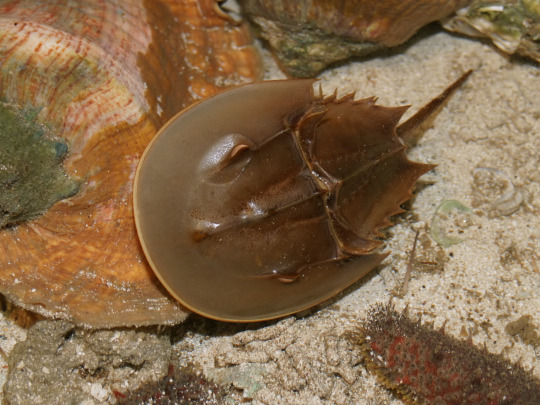
(image: a horseshoe crab from above)
While the most famous feature of the horseshoe crab it its large shell, there's a lot more going on on its underside. At the front of the body are the legs and mouth, which aren't all that distinct. Horseshoe crabs have 6 pairs of limbs. the front pair are known as chelicera, which are used to move food into the mouth. After that there are pedipalps, which most chelicerates use for food handling or for picking stuff up, but which horseshoe crabs use as another pair of legs. Males have modified pedipalps used for grabbing onto females when mating. Finally there are the true legs, the back pair of which is the one used mostly for pushing the animal forward. All legs except to back pair have claws that can be used for picking up food but are too weak to be used for defense. The mouth is located in the middle of the legs. The bases of the legs are rough and serve the same function as jaws, giving them the name gnathobases (gnatho means jaw). Imagine having your legs come out of your face and you have to walk around to chew and you know what it's like to be a horseshoe crab.
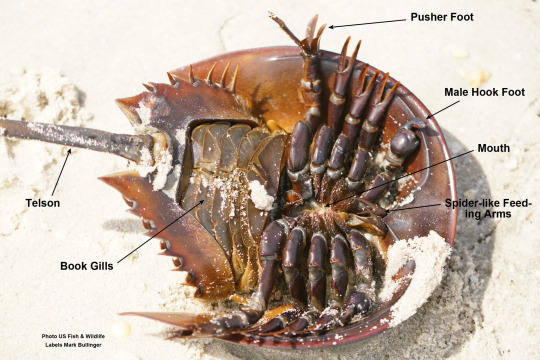
(image: a horseshoe crab with body parts labled)
After the legs comes the next body segment, which is home to the gills. Horseshoe crabs have book gills, which seem to be an evolutionary precursor to the book lungs seen in spiders and other arachnids. Horseshoe crabs have five pairs of these gills, each located on a flap that can move back and forward. Each flap is covered in over a hundred tiny membranes called lamellae that are used for gas exchange with the surrounding water. Horseshoe crabs keep their book gills moving rhythmically to keep water flowing over them. They can survive on land for several hours as long as their book gills stay wet. Because the gills can flap back and fourth, they are sometimes used to swim. This is only seen in young crabs as the adults are too heavy and they usually swim upside down.

(image: a horseshoe crab swimming upside down because I couldn't find a decent gif)
At the very back of the body is the telson or tail. Despite looking like a stingray tail and being related to a scorpion's stinger, the horseshoe crab's tail is harmless. They will raise it to try to scare off predators, but its main purpose seems to be flipping the crab over if it ends up on its back. The telson and legs can grow back slowly if removed. Like ofter chelicerates, horseshoe crabs have an exoskeleton and need to molt regularly, leaving behind their old shell. Females are larger than males, who will cling onto their shells during mating. Amusingly, some small horseshoe crabs will cling onto bigger ones just to get a free ride. They are predators whose diet consists mostly of small mollusks and worms. Horseshoe crabs prefer to live in shallow water with sandy sediment and are often found in bays and estuaries. Horseshoe crabs have 9 eyes. The most prominent are a pair of compound eyes that are easily visible on the shell. In addition, there are 3 pairs of simple eyes capable of seeing visible and ultraviolet light located behind the compound eyes, on the front of the shell, and on the underside by the legs. Another simple eye is the parietal eye located just behind the pair of simple eyes on the front of the shell. And if that isn't enough, they have a cluster of photosensitive cells on the tail. Horseshoe crab eyes have the largest rod and cone cells of any animal, over a hundred times the size of a human's. Despite this, they have very poor eyesight, mostly distinguishing between light and dark.
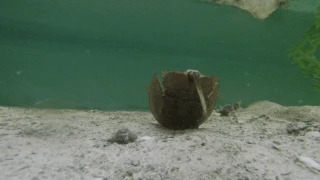
(gif: horseshoe crab righting itself)
There is one species of North American horseshoe crab and three Asian species. The one I am most familiar with and have had the chance to both see in the wild and handle is the North American Limulus polyphemus, which ranges from the Gulf of Mexico up along the Atlantic coast to Maine and southern Canada. Recent genetic studies have shown that there is very little mixing between a population around the Yucatan and the rest, possibly representing a subspecies or separate, related species. Some of the oldest DNA ever sequenced (about 2 million years old) was of L. polyphemus and was found off the coast of Greenland, suggesting their range was much larger in the past when the oceans were warmer. The northern population (north of southern Florida) Have a yearly mating season taking place in the spring during high tides and especially on the full and new moon. Females will crawl onto the beach to lay eggs in shallow burrows, which the males will then inseminate. Female can lay up to 80,000 eggs per year. It takes offspring about 9 years to become sexually mature and they can live an estimated 20-40 years. L. polyhemus has been extensively studied for topics including eyesight, circadian rhythms, and blood clotting.

(Image, mass horseshoe crab mating on a beach)
Horseshoe crabs have been studies for medical purposes regarding their blood. Their blood is bright blue and contains an important chemical called Limulus amebocyte lysate or Tachypleus ambeocyte lysate depending on whether it comes from the North American or Asian species. LAL/TAL reacts with a component in the cell membrane of gram-negative bacteria by clotting. This allows it to detect the presence of many species of bacteria, even dead ones. Tests using LAL allows scientists to detect contamination. The LAL test has been used in the US since 1977 and has been used for vaccine production, making horseshoe crabs responsible for saving millions of lives. To get the blood, companies will catch large amounts of horseshoe crabs and extract blood before returning them to the water where they will tell stories of being abducted by aliens to other, more skeptical crabs. The companies claim to have a mortality rate of 3-5%, but independent studies suggest the proper value should be 15-30%. A few artificial alternatives to LAL have been developed, but adoption of them has been slow and horseshoe crabs are still extensively caught and bled.
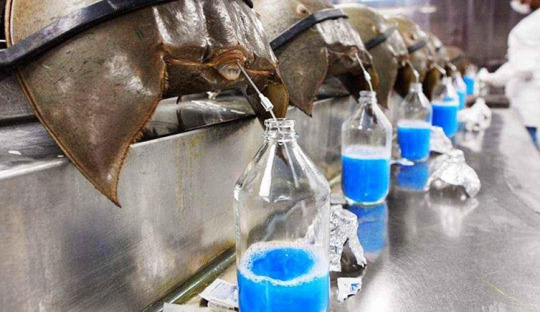
(image: horseshoe crab blood extraction)
The living species of horseshoe crab are all classified as vulnerable or endangered by the IUCN. Threats include habitat loss and fisheries. All species are fished for bait and the asian species and eggs are used for food. Catching for blood extraction also poses a threat. Horseshoe crabs are considered vital species in their environments and new protections should be enacted.
#wet beast wednesday#marine biology#biology#animals#ecology#zoology#horseshoe crab#animal facts#invertebrate#arthropod#critters
437 notes
·
View notes
Note
do you have any random fungi facts? i crave knowledge/silly
of course i do :-)
prototaxites : "a genus of terrestrial fossil fungi dating from the middle ordovician until the late devonian periods, approximately 470 to 360 million years ago."
these ancient organisms - the largest land-dwelling organism of its time - were recently verified to be fungi !!
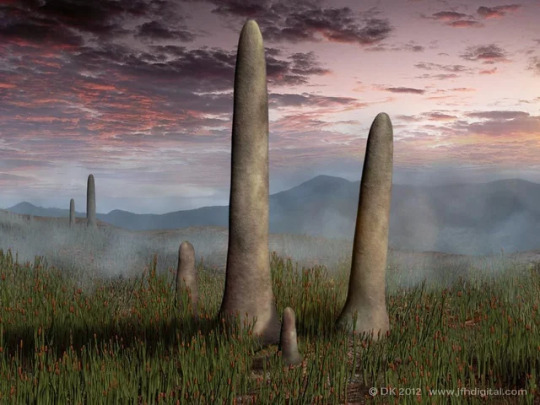

they grew up to 1 metre (3ft) wide & 8 metres (26ft) in height.
#thanks for the ask !! i really love these types of prompts :-)#||#• askbox replies: •#(ask : anonymous user)#[prototaxites]#|#fungi#fungus#mushrooms#nature#earth#cottagecore#mushroom#mycology#forestcore#foraging#biology#science#fossils
192 notes
·
View notes
Text
Trilobite of the Day 22

Actinopeltis cf. gryphus (Barrande, 1872)
Upper Ordovician, Middle Ashgillian
Kralodvorian Regional Stage
Basal Králův Dvůr Formation, Podolí Ore Horizon
Prague Basin, Czechia
Largest trilobite is 2.3 cm
"A slab of Czechian Trilobite buddies"
#trans paleontologist#transgender#trilobites#paleontology#posting#trilobite of the day#trilobite#invertebrate paleontology#fossils#geology
71 notes
·
View notes
Text


So to beginn the first speciemen of fossil for this post. Found today, not seen found before.
Likely some sort of porifea = sponge.
An with tiny silicat veins Astylospongia praemorsa.
After learning the name i got good reference pictures of it. My first find of this specimen!!
Findings of known deposits from astylospongia are in my area from belgium to middle germany poland to the baltic sea and goes up to north.
Brown like chert- flint near round bulb alike. Complete round underside without stem or breaks. Looking like an dry old fig fruit. 🤨
In wet condition its darker gray, with silica vein like struckture like some sponges have. Chestnut sized.
I leave the rugosa + horn coral species Id image here for the future, to lose quick compare.
# Ordovician sponge Astylospongia praemorsa
Prepare some warning for annoying ads from the Researchgate site of the article on the link.
#fossils#geology#fossil hunt#fossil collecting#fossil identification#fossil#fossil id#fossils in germany#fossils 2024#fossil friday
15 notes
·
View notes
Text

An article published in the journal "Nature" reports a study on a trilobite fossil of the species Bohemolichas incola dating back to around 465 million years ago, in the Middle Ordovician period, which reveals the contents of its guts in the last meal that occurred before its death. A team of researchers subjected the fossil in an extraordinary state of preservation to a sophisticated synchrotron microtomography that made it possible to create a 3D reproduction that also shows the contents of its intestinal tract. That revealed that this trilobite ate some marine invertebrates such as ostracods, bivalves, and echinoderms.
50 notes
·
View notes
Text
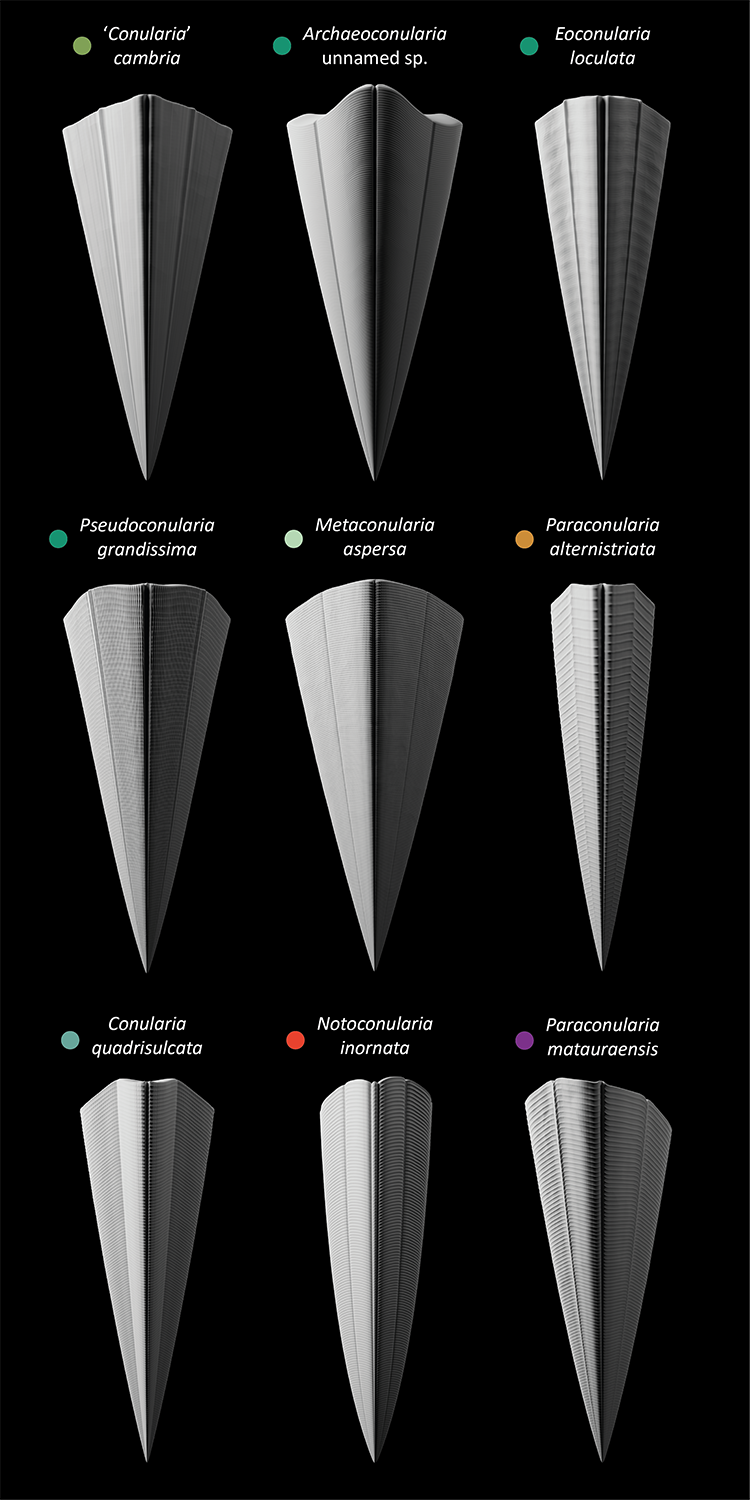
Conulariids are an extinct group of probable cnidarians with 4-sided pyramidal thecae. They are relatively uncommon fossils but ranged from the Cambrian (possibly Ediacaran?) to the Triassic, comprising tens of genera and hundreds of described species (Lucas 2012).
Here are the reconstructed thecae of a small selection of species from every period of the conulariids' range, starting from the Cambrian in the top left and reaching all the way to the Triassic in the bottom right.
Since their soft parts are virtually never preserved (due to them being cnidarians and all that) (Van Iten & Südkamp 2010), most of our knowledge of conulariid biology and evolution is based on their more fossil-friendly thecae, which were composed of thin organophosphatic lamellae (Leme et al. 2008). Live conulariids were attached to the substrate by the apex of their theca; they probably captured suspended food particles or small prey using tentacles, just like other cnidarians, but it's hard to go in any more (non-speculative) detail without preserved soft tissues.
References:
Babcock, L. E. (1986). Devonian and Mississippian conulariids of North America. Part B. Paraconularia, Reticulaconularia, new genus, and organisms rejected from Conulariida. Annals of the Carnegie Museum, 55, 411–479. https://doi.org/10.5962/p.215204
Guimarães Simões, M., Coelho Rodrigues, S., Moraes Leme, J. de, & Van Iten, H. (2003). Some Middle Paleozoic Conulariids (Cnidaria) as Possible Examples of Taphonomic Artifacts. Journal of Taphonomy, 1(3), 163–184.
Hughes, N. C., Gunderson, G. O., & Weedon, M. J. (2000). Late Cambrian Conulariids from Wisconsin and Minnesota. Journal of Paleontology, 74(5), 828–838. https://doi.org/10.1666/0022-3360(2000)074<;0828:LCCFWA>2.0.CO;2
John, D. L., Hughes, N. C., Galaviz, M. I., Gunderson, G. O., & Meyer, R. (2010). Unusually preserved Metaconularia manni (Roy, 1935) from the Silurian of Iowa, and the systematics of the genus. Journal of Paleontology, 84(1), 1–31. https://doi.org/10.1666/09-025.1
Leme, J. M., Simões, M. G., Marques, A. C., & Van Iten, H. (2008). Cladistic Analysis of the Suborder Conulariina Miller and Gurley, 1896 (cnidaria, Scyphozoa; Vendian–Triassic). Palaeontology, 51(3), 649–662. https://doi.org/10.1111/j.1475-4983.2008.00775.x
Lucas, S. (2012). The Extinction of the Conulariids. Geosciences, 2, 1–10. https://doi.org/10.3390/geosciences2010001
Sendino, C., & Zagorsek, K. (2011). The Aperture and Its Closure in an Ordovician Conulariid. Acta Palaeontologica Polonica, 56, 659–663. https://doi.org/10.4202/app.2010.0028
Slater, I. L. (1907). A monograph of British Conulariæ. Printed for the Palæontographical Society.
Thomas, G. A. (1969). Notoconularia, a New Conularid Genus from the Permian of Eastern Australia. Journal of Paleontology, 43(5), 1283–1290.
Van Iten, H., Konate, M., & Moussa, Y. (2008). Conulariids of the Upper Talak Formation (Mississipian, Visean) of Northern Niger (West Africa). Journal of Paleontology, 82(1), 192–196. https://doi.org/10.1666/06-083.1
Van Iten, H., Muir, L., Simões, M. G., Leme, J. M., Marques, A. C., & Yoder, N. (2016). Palaeobiogeography, palaeoecology and evolution of Lower Ordovician conulariids and Sphenothallus (Medusozoa, Cnidaria), with emphasis on the Fezouata Shale of southeastern Morocco. Palaeogeography, Palaeoclimatology, Palaeoecology, 460, 170–178. https://doi.org/10.1016/j.palaeo.2016.03.008
Van Iten, H., & Südkamp, W. H. (2010). Exceptionally preserved conulariids and an edrioasteroid from the Hunsrück Slate (Lower Devonian, SW Germany). Palaeontology, 53(2), 403–414. https://doi.org/10.1111/j.1475-4983.2010.00942.x
Waterhouse, J. B. (1979). Permian and Triassic conulariid species from New Zealand. Journal of the Royal Society of New Zealand, 9(4), 475–489. https://doi.org/10.1080/03036758.1979.10421833
敏郎杉山. (1942). 156. 日本産Conularidaの研究. 日本古生物学會報告・紀事, 1942(25), 185-194_1. https://doi.org/10.14825/prpsj1935.1942.185
#conularia#archaeoconularia#eoconularia#pseudoconularia#metaconularia#paraconularia#notoconularia#conulariid#cnidarian#paleozoic#mesozoic#palaeoblr#paleoart#my art
40 notes
·
View notes
Text
A rugosa fossil found in the synclinorium of Namur (Belgium)
The whole thing meassures less than a centimeter across and I almost missed it when I picked up this particular rock. I was lucky for my geology professor who was right there and who spotted this tiny treasure.
(Found by me and identified by my geology professor on 12/5/2022)
(I’m still a bit jealous of this girl who found a three centimeter long trilobite fossil on this excursion… some people are just so damn lucky)



The rugosa or horn coral are an extinct order of colonial corals that were most abundant in the Middle Ordovician to Late Permian seas.
#science#geology#fossils#cool rocks#stemlearning#stemblr#stemeducation#stem studyblr#stem academia#stem aesthetic#stem student#biology#biology student#college#university#marine biology#coral
17 notes
·
View notes
Text


Fossil Starfish Plaque
Petraster sp.
Middle Ordovician (approx. 467 million years ago)
Erfoud, Morocco
#Fossil Starfish Plaque#Petraster sp.#Middle Ordovician#Erfoud Morocco#Paleontology#Palaeontologists#fossils#ancient artifacts#history#history news#ancient history
42 notes
·
View notes
Text
Life in the Ordovician
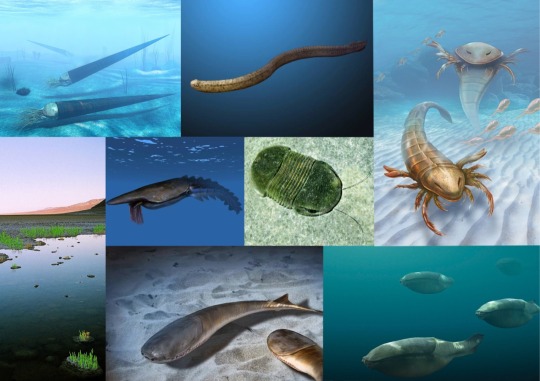
(top left: Endoceras; top middle: Promissum; top right: Pentecopterus; middle left: Aegirocassis; middle right: Bumastus; bottom left: first land plants; bottom middle: Sacabambaspis; bottom right: Arandaspis)
Art by:
Bumastus - Obsidian Soul
Promissum, Aegirocassis, Sacabambaspis - Nobu Tamura
Endoceras - AStepIntoOblivion
Pentecopterus - Patrick J. Lynch
Arandaspis - Christian Darkin
First land plants - Tahoenathan
After the Cambrian Explosion we reach the “Great Ordovician Biodiversification Event“ or GOBE (which, admittedly, sounds a lot less catchy than Cambrian Explosion).
The Ordovician starts directly after the Cambrian about 485 million years ago. Life really started to diversify during this period and came up with a lot of new and more modern forms (as far as you can call something that‘s 485 million years old “modern“). Groups like gastropods (slugs and snails), bivalves (shelled marine invertebrate) and brachiopods (shelled molluscs like clams, oysters, etc.) started to gain prominence. It really is a shame that, as a vertebrate myself, I am biased to things that also have bones and therefore won‘t talk a lot about those critters (maybe at some point i have to dig deeper into them). I can however tell you that those groups became very important to marine ecosystems and that the brachiopods especially are characteristic for the “paleozoic fauna“ in contrast to the “cambrian fauna“. Also, the fact that paleontologist distinguish between those two should give you a hint as to how impactful the GOBE really was.
Trilobites like Bumastus, which first originated in the Cambrian, were doing very well and diversified further. Most of them were bottom dwelling and relatively small, but the biggest ones, which lived during the late Ordovician could reach up to 70 cm. Just like the gastropods, bivalves and brachiopods, they were mayor players of their time, and just like them, they get concerningly little attention in relation to how big of a group they were and how important they were to our Earth‘s history. Although, I suppose I am part of the problem here, because I could go into deep detail about them right now. I‘m just not going to. Maybe some day…
While the trilobites were running around on the ocean floors some of the earliest chordates slowly turned into fish. They were of course a very basic type of fish. We call this group Agnatha, which translates to “no-jaw“, because, well, they didn‘t have jaws yet (they did have teeth though). Some jawless fish are still alive today, the lampreys and hagfish. They are truely disgusting, slimy, blood-sucking, eel-like creatures. The extinct jawless fish include the conodonts like Promissum. For the longest time scientists had no idea what kind of animal conodonts were, because the only parts of them that fossilized were their cone-shaped teeth (that‘s also where they got their name). Those teeth however were found everywhere and they are very important fossils, because by looking at them geologist can determine from which geologic age a fossil site is. Relatively recently we then started to find better preserved fossils, that revealed that conodonts where also eel-shaped and had big eyes. The other type of extinct jawless fish were the Ostracoderms like Sacabambaspis or Arandaspis. They are usually better preserved because their heads were covered in boney armor which fossilizes much better than the wiggly soft bodies of the conodonts.
One of the biggest names of the Ordovician was Endoceras, a shelled cephalopod (related to squids and octopus). And by big I mean that this weird ice cream cone was more than 3 m long. Another famous group that got their start during this time are the eurypterids, the sea scorpions, like Pentecopterus. Neither were they real scorpions (they were arachnids though, so close enough), nor lived they exclusively in the sea as there were a lot of fresh water species. There are some suggestions that they might have been able to at least briefly walk on land and breath in the air. They were also some of the biggest arthropods that ever live. Pentecopterus for example was about 1.7 m long and it wasn‘t even the biggest eurypterid (we‘ll get to that one later). They weren‘t all massive, but sizes of 1 m and more were not rare and to be honest, that‘s already way to big for any bug of my liking.
While all those new linages arose they slowly outcompeted many of the Cambrian weirdos I talked about last week. Some held on longer than others though. The Radiodonts (Anomalocaris and friends) declined during the Ordovician, but it was also the time during which we see the biggest one of them: 2 m long Aegirocassis. It was a filter feeder, so basically a giant whale of its time.
As all of that was happening in the oceans, another revolution happened quietly on the shores of our early planet: We see the very first land plants. Those early plants would have been non-vascular plants (vascular tissue is basically the plant equivalent to blood vessels; and it had not developed yet). They would have looked similar to mosses.
Even though those early plants wouldn‘t have looked very exciting, they would have put a lot of work into terraforming the world. It is believed that their photosynthesis lowered carbon dioxide levels in the atmosphere and that this might have caused temperatures to drop, turning the late Ordovician into an ice age. We know for certain that this drop in CO2 levels and temperature happened. If it was actually caused by the photosynthesis is another questions, though. Another suggestion, that also makes plants the culprits, is that their roots increased the erosion of rocks and this erosion involved the reaction between the rocks and CO2 from the atmosphere. Another reason for increased erosion could have been vulcanism creating a lot more “new“ rocks to erode. An (to my ears) absolutely wild theory is that the earth actually didn‘t cool because of lower CO2, but instead got hit by a gamma-ray burst, which sounds like something out of a scifi-movie. Apparently a gamma-ray burst is an intense energy beam, that is caused by a supernova (I really know nothing about space…), and it could have stripped our planet very quickly of our ozone layer. As ozone is a greenhouse gas, just like CO2, that would have also caused a cool down.
Whatever it was, at the end of the Ordovician the earth froze over. Drastic changes in temperature usually lead to extinction and that was the case here as well. The Late Ordovician Mass Extinction killed around 85 % of marine species, which is a pretty big deal when you consider, that almost all species at the time were marine species. It is often seen as the second-worst of the mayor “big 5“ mass extinctions (we’ll get to all the other ones in the future, don‘t worry about it). But, unlike many other mass extinctions, it didn‘t have a mayor impact on the fauna and most groups of life recovered and re-diversified after the extinction. But that‘s a story for another time.
Again, all the info from wikipedia. I got some stuff about jawless fish here.
12 notes
·
View notes
Text





Cameroceras
(temporal range: 470-425 mio. years ago)
[text from the Wikipedia article, see also link above]
Cameroceras ("chambered horn") is a genus of extinct, large orthoconiccephalopod that lived mainly during the Ordovician period. It first appears during the middle Ordovician, around 470 million years ago, and was a fairly common component of the fauna in some places during the period, inhabiting the shallow seas of Laurentia, Baltica and Siberia.[3] Its diversity and abundance became severely reduced following the Ordovician–Silurian extinction events, and the last remnants of the genus went extinct sometime during the Wenlock.[3]C. rowenaense from Cincinnati had shell length about 70 centimetres (2.3 ft), and unnamed species had length about 1 metre (3.3 ft).[3] Although in older literature Cameroceras was treated as the largest nautiloid with shell length about 6 metres (20 ft) or even 30 feet (9.1 m),[4] later study shows that the large-sized species no longer belongs to genus Cameroceras but Endoceras giganteum instead, and the 30 feet (9.1 m)-long specimen is highly doubtful.
8 notes
·
View notes
Text

I've got a geologic timeline running along the walls of my new appartment, so I made some icons to mark the mass extinctions on it! They depict the Big Five, plus the End-Ediacaran extinction, some in a more literal fashion and some more metaphorically. Detailed look and explanations in reverse chronological order below the cut.

Cretaceous Paleogene Extinction: Meteorite hitting the Earth.

End-Triassic Extinction: Pangaea split by a line of fire to show the future mid-oceanic ridge massively erupting as the supercontinent breaks up.

The Great Dying: To depict the worst extinction of all time, I drew the Earth as a skull.

Late Devonian Extinction: The Late Devonian extinction may have been set off by the evolution of trees completely changing how the world's climate and cycles worked. By breaking up rock into soil they released massive amounts of nutrients into the environment, leading to anoxic waters. They reduced the CO2 in the atmosphere, causing a temperature drop. The knock-on effects of all this, possibly combined with a volcanic period, resulted in a mass extinction. To try and depict the trees indirectly killing life, I drew them literally killing it with their roots. Some of the victims are lobe-finned fish, jawless fish, brachiopods, trilobites, crinoids, and cystoids. Another root is turning into an ice crystal and another into a very eutrophic pool of algae-infested water.

Ordovician-Silurian Extinction: This one is considered to be the result of an ice age, so I drew a snow crystal. The middle part is also meant to be reminiscent of a bright star, in reference to the (not especially probable) hypothesis that it was set off by a nearby supernova.

End-Ediacaran Extinction: I really struggled with this one, as it's still fairly poorly understood, but is thought to involve a major anoxic event. But how do you clearly depict a lack of oxygen? It's not easy without resorting to drawing choking humans or crossed out oxygen formulas and such. Instead, I depicted the results of it: the disappearance of the Ediacaran biota and their replacement with the more familiar creatures of the Cambrian. This is a trilobite crawling over the fossils of a Dickinsonia, Charnia, and Tribrachidium.
#extinction#mass extinction#k-pg extinction#end-triassic extinction#the great dying#late devonian extinction#ordovician-silurian extinction#end-ediacaran extinction#cw: animal death
6 notes
·
View notes
Text
You know plants? Land plants, I mean, not the underwater ones. Those things with the green and the leaves?
Yeah, well they first appeared in the Ordovician period. This was the second of six periods of the Paleozoic era, and began about 450 million years ago.
If I took you, made you immortal, dropped you in the middle of this period, and gave you a dollar every day, by now you'd still be poorer than elon musk
3 notes
·
View notes